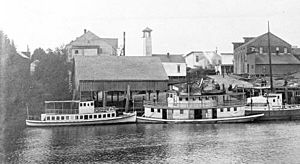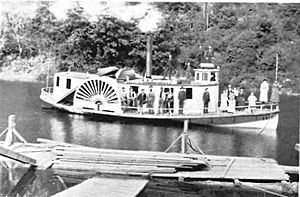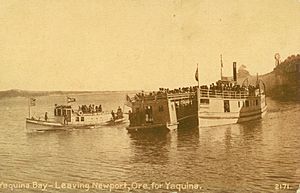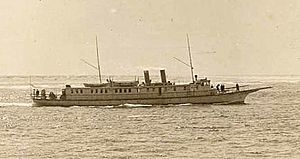Steamboats of the Oregon Coast facts for kids
Imagine a time before cars and trains were common! In the late 1800s, people living along the Oregon Coast used steamboats to travel and move goods. These boats were super important because there weren't many roads or railroads back then. This article tells you about the small steamboats that worked on the rivers and bays of the Oregon Coast. They were much smaller than the huge steamboats on bigger rivers like the Columbia. Because there were so many of them, and they were small, people called them the "mosquito fleet."
Contents
- Exploring Oregon's Coastal Waterways by Steamboat
- Rogue River: Steamboats and Fish Canneries
- Coquille River: A Key Transportation Route
- Coos Bay: A Busy Harbor for Steamboats
- Umpqua River: The Long Journey to Roseburg
- Siuslaw Bay and River: Local Travel
- Yaquina Bay: Bringing Tourists to the Coast
- Siletz River: Salmon and Supplies
- Tillamook Bay: A Resort Connection
- The End of the Steamboat Era
- Where Steamboats Rest: Graveyards and Wrecks
- List of Coastal Steamboats
Exploring Oregon's Coastal Waterways by Steamboat
Rogue River: Steamboats and Fish Canneries
The Rogue River flows from the Cascade Mountains all the way to the Pacific Ocean at Gold Beach. A clever businessman named R. D. Hume was a pioneer here. He built a fish cannery and a special steamship called Mary D. Hume in 1881. This ship helped his cannery business.
In 1901, another captain, E.D. Burns, brought his own steamboat, Rogue River, to compete with Hume. In November 1902, Captain Burns tried to go very far up the Rogue River to Agness. But on the way back, his boat hit a rock! The boat was wrecked, and its boiler was still visible many years later. This was the only time a regular steamboat went so far up the Rogue River.
The Mary D. Hume was a tough ship. She was still working in 1939, making her the oldest commercial ship in the Pacific Northwest!
Coquille River: A Key Transportation Route
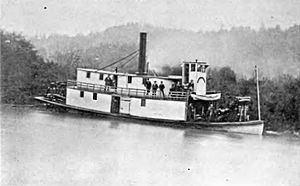
The Coquille River flows inland from Bandon. Before cars and trains, this river was the main way to travel. It connected Bandon to towns like Coquille and Myrtle Point in southern Coos County. Steamboats were essential for moving people and goods along this waterway.
Coos Bay: A Busy Harbor for Steamboats
Coos Bay is a large, but mostly shallow, harbor on Oregon's southwest coast. It's a very important harbor, especially between San Francisco and the Columbia River.
Steamboat captains started working on Coos Bay in 1873. They used smaller riverboats to navigate the bay and the rivers flowing into it. To make travel easier, a special railroad was built in 1874. It connected Coos Bay to the Coquille River, allowing steamboats from both areas to link up.
Many steamboats were built here over the years. However, 1912 was a bad year. Several steamboats were wrecked due to crashes, fires, or getting stuck on the sandbar at the bay's entrance.
Umpqua River: The Long Journey to Roseburg
The Umpqua River runs from Reedsport up through Douglas County. The town of Gardiner, near the mouth of the Umpqua, was a place where many river steamers were built.
Captain Godfrey Seymour started steamboat services on the Umpqua. His boat, Swan, did something amazing in 1870. It was the only steamboat ever to travel all the way to Roseburg! Roseburg is 85 miles upriver. It took Swan 11 days to get there. This trip convinced the government to spend money clearing the river, even though no other steamboat ever went that far again.
Siuslaw Bay and River: Local Travel
Siuslaw Bay is another large, shallow bay on the Oregon coast. The Siuslaw River flows into this bay, which meets the ocean near Florence. Around 1890, a steamboat called Moonlight began service on Siuslaw Bay. It helped people travel through the bay and its many small channels.
Yaquina Bay: Bringing Tourists to the Coast
Yaquina Bay is another shallow bay on the Oregon Coast. The main town here is Newport. When the Oregon Pacific Railroad reached Toledo, tourists started coming to the bay. Roads were bad or didn't exist, so the only way to get to the hotels in Newport was by steamboat across Yaquina Bay. Many propeller steamboats provided this service.
Siletz River: Salmon and Supplies
The Siletz River flows into the Pacific Ocean about 30 miles north of Yaquina Bay, near Lincoln City. In 1896, the first salmon cannery was built on the Siletz River. The owner, Daniel Kern, brought in a small steamer called Tonquin. This boat helped the cannery by bringing supplies and moving fish.
Later, in the 1920s, the Siletz Navigation Company operated on the river. A strong diesel freighter called Siletz was launched in 1923. This boat was so sturdy that it even traveled all the way to Hawaii in 19 days!
Tillamook Bay: A Resort Connection
Tillamook Bay is a large, very shallow bay on the northern Oregon Coast. In 1911, a fancy yacht named Bay Ocean was built. It was meant to take passengers from Portland to a new beach resort on Tillamook Bay.
Bay Ocean was the biggest motor passenger ship built on the Pacific Coast at that time. It was long and narrow, with a special front end. It could carry 50 passengers. However, it was difficult to use on the route and only ran in the summer. During World War I, the Navy used Bay Ocean as a patrol boat.
The End of the Steamboat Era
The "mosquito fleet" continued to operate in the Coos Bay area and Coquille River valley until the 1930s. This was because these areas still didn't have good roads or other modern ways to travel. For example, a small gasoline-powered boat called Welcome, built in 1919, ran on the Coos River until 1948!
Where Steamboats Rest: Graveyards and Wrecks
When steamboat service ended on the Coquille River, some boats were simply left on the riverbank near Bandon. These included Myrtle, Telegraph, and Dora.
The Mary D. Hume, built in 1881, is still mostly there! She lies on the shore at Gold Beach, Oregon. Her wreck is so important that it's listed on the National Register of Historic Places.
The steam ferry Roosevelt, which used to run on Coos Bay, was photographed abandoned near Marshfield in 1941.
List of Coastal Steamboats
Many different types of boats were built and used on these waters. They were powered by steam, gasoline, and diesel engines. This list focuses on some of the more interesting or larger vessels built before 1920.
| Name | Type | Year Built | Where Built | Builders | Owners | Gross Tons | Length | Disposition |
|---|---|---|---|---|---|---|---|---|
| Swan | sternwheeler | 1870 | Gardiner | Godfrey Seymour | 131 | unknown, 1880 | ||
| Enterprise | sternwheeler | 1870 | Gardiner | Godfrey Seymour | 247 | wrecked 1873 | ||
| Oneatta | sidewheeler | 1872 | Pioneer | 118 | 82' | transferred to Columbia River, circa 1874, then to California 1882 | ||
| Messenger | sternwheeler | 1872 | Empire City | Capt. M. Lane | 136 | 91' | burned 1876 at Coos Bay, total loss | |
| Little Annie | sternwheeler | 1877 | Coquille | William E. Rackliffe | 86 | 70' | hit snag and sank near Bandon, 1890 | |
| Mud Hen | sternwheeler | 1878 | Coquille River | 32' | unknown, 1892 | |||
| Mary D. Hume | propeller cannery tender | 1881 | Ellensburg | R.D. Hume | R.D. Hume | 158 | 98.1' | sold in the late 1880s to Alaska whaling interests, later a cannery tender in Alaskan waters, reengined several times, and in service as late as 1939. Currently lying on shore at Gold Beach |
| Dispatch (I) | sternwheeler | 1890 | Bandon | 24 | 52' | unknown, probably abandoned 1904 | ||
| Alert | sternwheeler | 1890 | Bandon | Hans Reed | 96 | 69' | Transferred to San Francisco in 1919, foundered Sept. 26, 1919, near Rio Vista. | |
| Eva | sternwheeler | 1894 | Portland | Umpqua Steam Nav. Co.; W.F. Jewett | 130 | 90' | unknown, 1918 (probably abandoned) | |
| Favorite | propeller | 1900 | Coquille | Arthur Ellingson | 13 | 72' | unknown, 1917 | |
| Pastime | sternwheeler (gasoline) | 1900 | Coquille | 11 | 45' | unknown, 1901 | ||
| Rogue River | sternwheeler | 1901 | Portland | E.B. Burns | 66 | 80' | wrecked, Boiler Rapids on Rogue River, 16 November 1902 | |
| Welcome | sternwheeler | 1900 | Coquille | S.H. Adams | 30 | 56' | wrecked, 1907 | |
| Echo | sternwheeler | 1901 | Coquille | Ellingson | 76 | 66' | unknown, probably abandoned 1911 | |
| Dispatch (II) | sternwheeler | 1903 | Parkersburg | Charles Tweed | 250 | 111' | rebuilt 1922 as towboat John Wildi | |
| Liberty | sternwheeler | 1903 | Bandon | Herman Bros. | 174 | 91' | unknown, 1918 | |
| Success | sternwheeler (gasoline) | 1903 | Gold Beach | 14 | unknown | |||
| Juno | propeller | 1906 | Marshfield | 32 | 60.8' | unknown | ||
| Millicoma | sternwheeler | 1909 | Marshfield | Frank Lowe | 14 | 55' | later converted to gasoline engine, rebuilt 1917 as propeller, ult. dispo unk. | |
| Newport | propeller | 1908 | Yaquina | 81 | 72' | converted to gasoline power, ran until the mid-1920s, ultimate disposition unknown | ||
| Charm | propeller (gasoline) | 1908 | Prosper | Herman Bros. | 75' | Badly damaged by collision with Telegraph 1914, and forced to beach near Bandon. Repaired and ran on Coquille River until sale to Shaver Transportation Co. in 1928. | ||
| Pedler | sternwheeler | 1908 | Marshfield | S. Gilroy | 407 | 124' | unknown, 1910 | |
| Coquille | propeller | 1908 | Coquille | Frank Lowe | 407 | 124' | transferred to Columbia R., date and ultimate dispo. unk. | |
| Myrtle (I) | sternwheeler | 1909 | Myrtle Point | Nels Nelson | Myrtle Point Trans. Co. | 36 | 57' | rebuilt as freighter 1922. |
| Sunset | sternwheeler | 1909 | Prosper | Carl Herman | Fredrick Elmore Drane Line | 12 | 40' | Registry # 206414 sank November 2, 1924 at 6:30 a.m. on the Coquille River at Bandon, Oregon resulting in the drowning death of Clarence Henry Hurley (06/22/1880 - 11/02/1924), president of the C. & C. Cedar Company of Bandon, Oregon. Salvaged and remained in service until abandoned June 30, 1929. |
| Dora | sternwheeler | 1910 | Randolph | Herman Bros. | W.R. Panter | 47 | 64' | abandoned 1927 |
| Bayocean | propeller yacht (gasoline) | 1911 | Portland | Joseph Supple | T.B. Potter Realty Co. | 130 | 150' | taken into naval service during First World War on April 27, 1918, decommissioned March 14, 1919, sold to L. Parker, of Oakland, CA |
| Fay No. 4 | sternwheeler (gasoline) | 1912 | North Bend | 179 | 136' | Transferred to California, 1913 | ||
| Lifeline | propeller (gasoline) | 1912 | Marshfield | 179 | 136' | Foundered off coast June 5, 1923, just south of Neahkanie Mountain, while en route from Coos Bay to Kelso. Crew survived, hull washed ashore and buried by sand. | ||
| Rainbow | sternwheeler | 1912 | Marshfield | Frank Lowe | Coos River Trans. Co. | 75 | 64' | Abandoned 1923 |
| Telegraph | sternwheeler | 1914 | Prosper | Carl Herman | Myrtle Point Trans. Co. | 96 | 103' | rebuilt and lengthened to 115' in about 1916, abandoned by 1940 |
| Relief | sternwheeler | 1916 | Coquille | Ellingson | 44 | 64' | unknown, 1927 | |
| Myrtle (II) | sternwheeler | 1922 | Prosper | 36 | 60' | abandoned by 1940 | ||
| John Wildi (ex-Dispatch) | sternwheeler | 1922 | Parkersburg | 173 | 112' | abandoned 1927 | ||
| Siletz | diesel freighter | 1923 | Kernville | 93 | 64' | transferred to Hawaii, renamed Moi, and operated there by Young Bros. |


